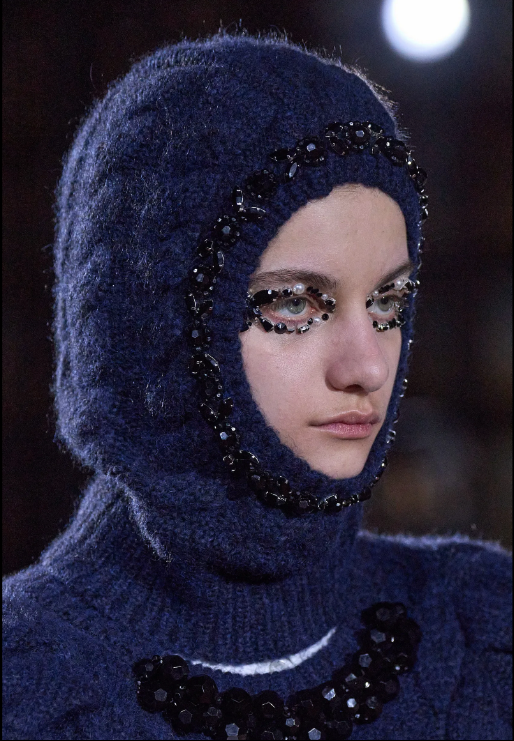Hide and Chic
The balaclava trend, the incognito intrigue, and the erotics of obscurity
Look #17 from the Simone Rocha AW22 show. Image via Vogue Runway. © All rights belong to their respective owners. No copyright infringement intended.
In hindsight, from trench to trend, the balaclava’s origin story is hardly sexy. The Battle of Balaclava, Crimean War. 1854. Caustic Cold. British soldiers. A humble knitted tube designed to keep a face on its bones. Necessity first, fashion as the afterthought, as is often the case. Beyond warfare and Celsius deficiency, we know that garments are never just garments for long. They absorb things: energy, ideology, desire, identity. Fashion, with its talent for extraction and recontextualisation, rarely leaves utility alone. Through every stitch of its time, the balaclava has known a multitude of significances, be it in war, resistance, music, or eroticism. By the time balaclavas appeared in the arsenals of protestors and anarchists in the 20th century, they had already transformed from survival gear to symbol. As early as the 1960s and 70s, balaclavas anonymised the radical body while sharpening its tenor. Such was the power of obscured identity, of refusal. No face, no case.
Let’s pull that thread.
Jumping forward to our contemporary fashion scene, across runways and quotidian streetwear, the balaclava isn’t just meant to hide you, but reorganises you aesthetically. Demanding attention with what’s erased, it insists upon selected focal points, sharpening or softening what remains visible. Cheekbones, irises, the tilt of a jaw, the suggestion (after all, the oldest flirtation) of lips under fabric. It’s no surprise that BDSM culture finds resonance here. In fashion, obscurity and restraint are often entangled with control. Rick Owens and Gareth Pugh emerge as prominent examples of these influences. Today’s balaclava trend retains parts of that language, but translates it. Various labels have striven to domesticate its taboo bearings, rendering the look more palatable for the brunch crowd. High fashion rechristens the garment as a 'hooded snood' or 'mask beanie,' sanitising its connotations while cashing in on its edge. Of course, here, irony pays its contribution. The balaclava, a previous symbol of radical resistance and the clandestine ‘Other,’ has been so easily gentrified into exorbitant luxury.
Then again, high fashion thrives on this tension—the ability to absorb the transgressive and repackage it into a million different things (for a multi-million profit). Gucci sends balaclavas down the runway in vibrant lace, Simone Rocha combines jewels with saintly gossamers, and Balenciaga implements jet black latex. Perhaps it’s precisely the customisability that drives the appeal of such trends. Balaclava is never just one thing, it keeps you guessing. This incognito upholds the intrigue, the unfixed profile of both wearer and way of being worn. Balaclavas invite us to imagine how style can look when liberated from the compulsion to maximise showing one’s face. It choreographs a state of visible expression without offering oneself entirely. The face, that ever-chattering billboard of identity, becomes muted. What we’re left with is posture, texture, silhouette, and intention. What distinguishes black latex balaclava wearer from the pastel mohair one? Rather than anti-social, the balaclava becomes extra-interactive; it plays with the thresholds of perception. Coverage becomes hypervisible, prompting us to look more, to look for longer, to look beneath.
From left to right, looks #28 and #24 from Heliot Emil AW22 Show. All images via SHOWstudio. © All rights belong to their respective owners. No copyright infringement intended.
Much of the balaclava’s re-emergence is rooted, interestingly and yet predictably, in the global COVID-19 pandemic. The face mask, then clinical and routine, ushered in a new normality of partial visibility. The nose, the mouth, the cheekbone all became zones of heightened attention, not through novel exposure but through absence. So, does such obscurity beget desire? In a 2022 study conducted by Leder et al., participants were presented with photographs of individuals in mundane situations with and without masks. They were asked to evaluate their attractiveness, likeability, and character. Studies found that those wearing masks were perceived as more attractive and valuable by some participants. As well, Olivera-La Rosa et al. (2020) found that face masks can increase trustworthiness in interpersonal communication, a finding that was replicated by Oldmeadow and Koch (2021). The pandemic didn’t just bring face masks into mainstream acceptability, it idealised the covered face in social exchange. We learned to identify attractiveness in a pair of eyes, emancipated from lower facial context. We made acquaintances with some we’ll never know beneath the bridge of a nose. It’s not so far-fetched to claim the balaclava trend builds on that muscle memory, extends that cultural training. It trades the clarity of countenance for drama in the partly, if at all, legible. In place of public health policy, the balaclava stretches concealment into sartorial provocation.
Whether in the techno-futurism of Heliot Emil or the casual elegance of Proenza Schouler, the balaclava has become shorthand for cool. It exudes a calm control. You might not see my mouth. You might not see what I feel. Whether or not we consider it power, the gesture of remaining unreadable—undissected—is a deliberate stance within a culture addicted to oversharing. Society’s agenda makes perpetual demands for immediacy, invasion, and exposure. As a product, our behaviours, expressions, and interactions become increasingly demystified. Any token of serendipity is often spent before the count begins. In this climate, the balaclava asserts a kind of creative disobedience, to be hidden in plain sight. Concealment on one’s own terms becomes its own mode of exposure. It suggests that fashion's latest provocation isn’t necessarily more skin, but maybe more fabric. The boundary inverts the equation, it withholds. In seeing less, we’re invited to see differently. In that subtle obscurity, we might just find what resembles a slight rebellion—or at least, a commendably polished outfit.



